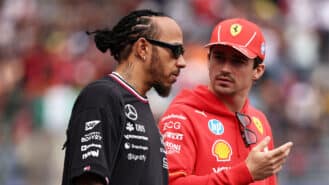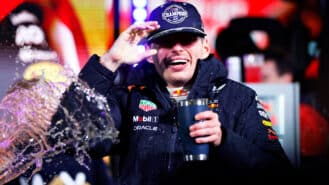
Verstappen proves Russell right: Abu Dhabi GP 2024 – Up/Down
Verstappen's prang at the first corner of the F1 finale in Abu Dhabi vindicated George Russell's recent rant
I have just climbed, somewhat breathless, from the driver’s seat of the new Porsche 911, mind too full of whirling images to marshal so soon and into a space such as this. When I have calmed down I will write a hopefully considered road test and include it in next month’s magazine. But, for now, I don’t think I can keep a few preliminary thoughts to myself.
First, not everyone is going to like Porsche’s idea of what’s most important in a new 911. It may look superficially similar to the 997-series car it replaces, but in all important areas barring its powertrain, it’s not just a completely new car, it’s a completely different car too.

And if, like me, you found the idea that the 997 needed replacing entirely ridiculous, you could easily emerge from the new car – confusingly coded 991 – with the conviction that it represented change for change’s sake.
Indeed if you were lucky enough to jump out of a 991 and drive one of its forebears from a generation earlier over the same stretch of the road, you might even conclude it’s turned into a kind of anti-911. Even by the standards of the day, those earlier cars are astonishingly flawed. I drove a 1987 3.2-litre Carrera ClubSport and found myself laughing at how bad was its driving position, pedal arrangement, gearshift, ergonomics, heating, ride and refinement. It didn’t even handle well, displaying the same old propensity to lock its front brakes too soon and slide quite viciously at either end under only mild provocation. All of which, of course, was fine because despite, and just maybe because of, these flaws, it was ultimately involving. After 20 minutes flinging it up a mountain road, I was in love.

Or at least I thought I was. In fact what I think I was in love with was the process required to drive it safely and well. It made me think I was driving well because if you did not constantly manage the car and make considered inputs to each pedal and the steering every time, you knew your punishment would be fast and fierce. Finding yourself able to cope with all the things it did wrong is what made you feel good. To design a car so bad it’s good is a neat trick, and it turned the 911 into the world’s most enduring, iconic sports car.
Which is why the new 911 seems like a mirror image of the old. Sure it still has a flat-six motor in its boot, but there all similarities end. In every area where the old 911 was flawed, this one is fabulous and the reason has very little to do with technological advances and rather more to do with the changed priorities of Porsche and its customers. The 991 is as easy as a Golf GTI to drive fast or slow – there’s no challenge any more because the truth is that the tables have turned: through the use of its stability systems, torque vectoring and electronically controlled suspension, it spends far more time managing your failings than vice versa.
So whether the 991 represents a step forward, back or to the side depends on where you’re viewing it from. Is it as rewarding to drive on its door handles as 911s of old? Clearly not. Is it the most capable and impressive all-purpose sports car the world has yet seen? Without a doubt. Is it, then, a better Porsche but a worse 911? By the time the next issue comes out, I’ll have an answer.

Verstappen's prang at the first corner of the F1 finale in Abu Dhabi vindicated George Russell's recent rant

FIA president Mohammed Ben Sulayem seemed intent on making F1 a united front by the end of the 2024 Qatar GP – against him

Leclerc erupted after feeling wronged one time too many by Sainz in Vegas – but the challenge posed by his team-mate next year, Lewis Hamilton, will be much greater writes James Elson

2024 has been Max Verstappen's masterclass – it should go down in history as one of F1's greatest titles